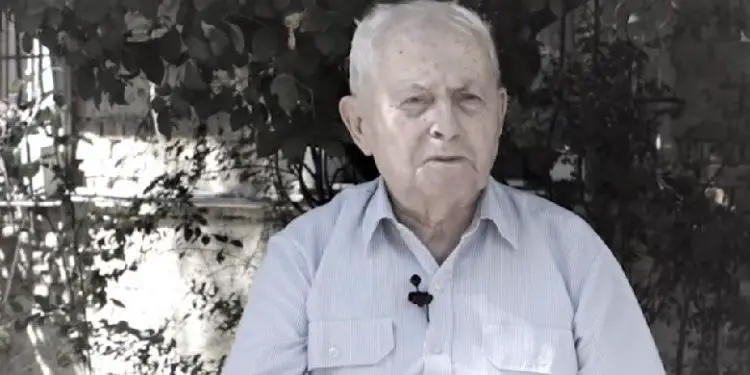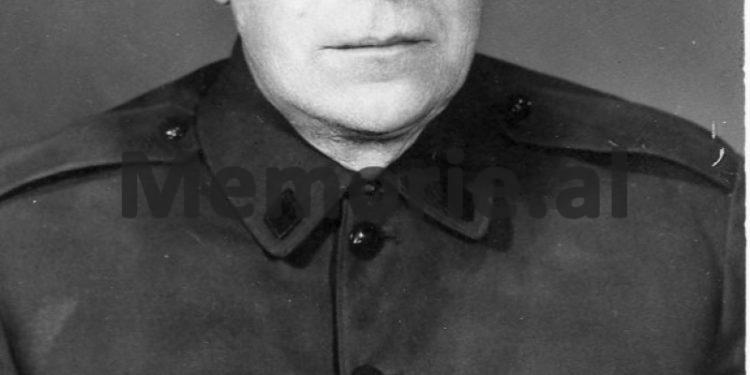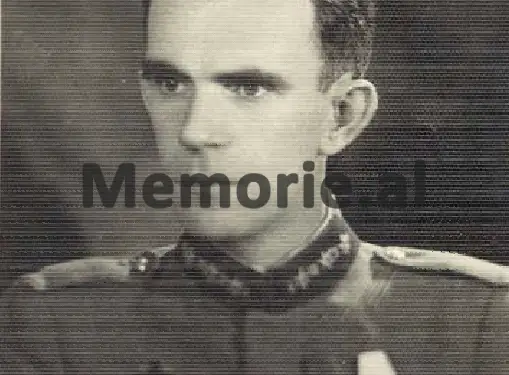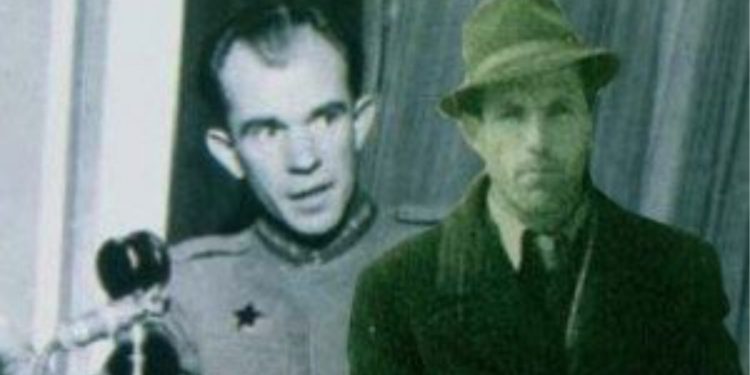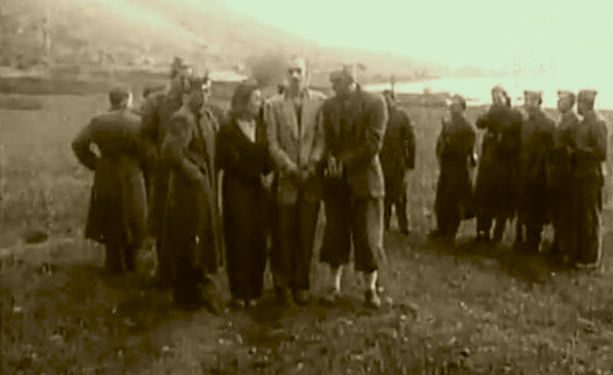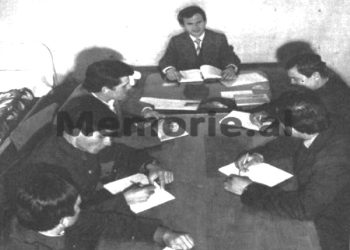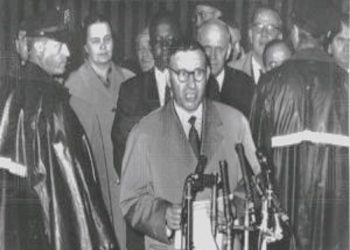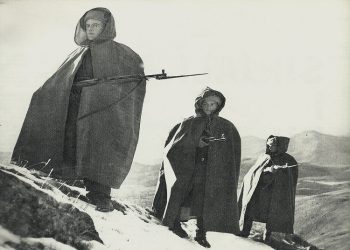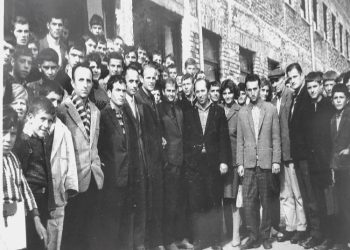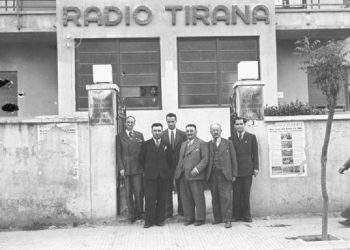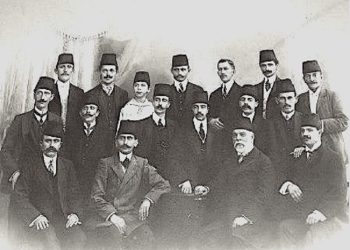From Agim Musta
The first part
Memorie.al / Agim Musta were born in the city of Gjirokastra in 1930, where his family originated from. He completed primary school in his hometown, while he finished high school in Tirana. After graduating from the Language-History Faculty, for a decade he served as a history teacher in the districts of Saranda, Kuçova and Tirana. In 1962, he was sentenced by the Military Court to 13 years in prison for anti-communist activity. After the 90s, Agim Musta engaged in writing and journalism, publishing in the press of the time, mainly the topic of the communist regime of Enver Hoxha and his crimes. Similarly, during this period of time, he also published several books, such as: “Living Files”, 1994; “Who was Enver Hoxha”? (as co-author), 1996; “State Prisons”, 2000; “Things about communism in Albania”, 2001, “This is how it happened”, 2003, etc. The article that we have selected for publication is about one of the most hated characters of Enver Hoxha’s communist regime, Major General Nevzat Haznedar, the terrible and cruel investigator, whom the author himself gave the epithet “the black general”, as and the article “Death Camps”, in which the still unsolved problem of finding the places where the victims of the communist dictatorship were executed, from 1944 until the collapse of the regime in 1990, is touched upon.
BLACK GENERAL, NEVZAT HAZNEDARI
I knew Nevzat Haznedar as a face as early as 1947, when he, as a military prosecutor, had become ruthless in the trials that took place in the “17 November” Cinema in Tirana, against the so-called “hostile groups”. His big head like that of the old Slavs stuck in my memory; his body strong, but a little stooped; his steel-colored eyes, which freed even concrete-Armenia, and his hands, like the paws of a Siberian bear. I had been told that he came from a family of ruined beylers of Leskovik. During the thirties, his father used to frequent the cafes of Korça, in a miserable condition, until he died on the street and was buried by the municipality.
At that time, Nevzat attended the “Normal” school in Elbasan, with a state scholarship. In “Normale”, his friends called him by the nickname “wild”. His favorite literature was torture novels. In 1938, after finishing the “Normal” of Elbasan, he was appointed a teacher in Postenan village of Leskovik. His former students say that they used to get away with it when the teacher threatened them even for the smallest mistakes. After he could not make a career in the Fascist Party, during the period 1939-42, he took off the black shirt and put on the red shirt, becoming one of the leaders of the Communist Movement, in the sub-prefecture of Leskovik, together with Kiço Kasapi and Ali Glina.
In the spring of 1943, he shoots Gaqo Tashko, along with his son, Petraq and Petro Tashko, in the gorge of Postenan, for the sole fault of having distanced themselves from the National Liberation Movement, when they realized that it was being led by the Communists. . At the end of 1944, Muharrem Rusi, former mayor of Leskovik Municipality, a man honored and respected throughout the province, was executed. Right after the establishment of the communist dictatorship, Nevzat was assigned the duty of the military prosecutor of Korça District, where he became famous for his exploits and misfortunes.
Takes part in the execution of the group of engineers of Kêneta i Maliqi in November 1946, throwing, with his own hand, the rope around the throats of Abdyl Sharra and Kujtim Beqir. Mr. Ali Selenica, lawyer, who died in Burrel prison in 1963, while serving his sentence, told me that at the beginning, when he worked as a lawyer in the city of Korça, the communist military court, with prosecutor Nevzat Haznedari, gave every day “in the name of the people”, 10-15 death sentences. Most of the convicts were illiterate intellectuals and peasants who had gone with the nationalist forces of the National Front.
The trial made no distinction between the truly guilty and the innocent. The “sword” of the communist dictatorship, in the hand of the criminal Nevzat, fell cruelly on the heads of innocent people. Even the simplest legal norms were violated. Such trials were not held even during the time of the Inquisition and no, no, during the Ottoman rule. No matter how patient and cowardly you were, you were revolted by this brutally raped “justice”.
“I was revolted – Mr. Selenica told me, – when Nevzati demanded the death penalty for a ballistic missile from the villages of Devolli, who was mute. He accused him, among other things, of being a ballistic devil, of having developed propaganda against the National Liberation Movement”.
Mr. Ali, as the defendant’s lawyer, said that the accusation against his client was as absurd as it was ridiculous, since the accused was mute and could not have committed the crime of agitation. Nevzat had insulted the lawyer with the dirtiest words and had accused him of being a fascist and for that reason fiercely defending the enemies of the people.
Mr. Ali Selenica retorts with prosecutor Nevzat, saying that he was a fascist, which was known by the entire Korça District. Captain Nevzati is furious with anger and demands the suspension of the court session. Lawyer Selenica, after an hour, found himself handcuffed in a dark cell of the State Security in the Internal Affairs Branch of Korca.
After three months of torture, carried out personally by Nevzati, Mr. Ali was sentenced to life imprisonment, as an “enemy of the people”, while his two sons, to escape persecution, were killed trying to cross the Albanian border. Greek within 11 years (1945-’56), taking hundreds of people to the other world, executioner Nevzat Haznedari managed to get the rank of general, becoming a symbol of state crime. There were no arrestees for “hostile” matters that Nevzati had not interrogated and “caressed” with his paws.
There was no prisoner who had escaped without bleeding from an encounter with him. Even the little executioners in the investigative offices, in the prisons and concentration camps, stood before him like chickens. He passed through his hands with thousands of victims, from simple villagers to prominent intellectuals, ministers, generals and members of the Political Bureau, ending his career with the “coup group” of Beqir Balluku.
In 1954, when the political prisoners in camp no. 4 in Tirana tried to open a tunnel to escape from the communist hell, Enverian “justice” fell mercilessly on the heads of those unfortunates who wanted to gain their freedom unjustly robbed. Over 20 people were sentenced to heavy prison terms and 4 of them: Abdulla Bajrami, Mark Zefi, Isuf Velçani and Zyhdi Mancaku, were executed in the cells of the old prison of Tirana by executioner Haznedar, cracking their skulls with an iron crowbar.
I had a personal meeting with this “Lucifer” in an investigation room of the Tirana prison, in April 1962. He was accompanied by 3-4 major officers, who were standing right behind him. Handcuffed, they sat me on the defendant’s concrete chair, while General Nevzati, with a ruler in his hand, asked me what I had discussed with his bailiff, teacher Fatmir Berati. I told him that with Fatmir, I had been a colleague at the “50-anniversary” school of the Textile Factory and I was not close enough to discuss political issues with him.
He started shouting loudly and turned to the officers, telling them that we should be lynched, but what to do with Comrade Enver, who said the law should be enforced. “These bastards wanted to reform the Social-Democratic Party, which Musine Kokalari could not do in 1946, and they will suffer worse than her”!
With an outstretched arm, as if he were going to split wood, he put a ruler on my shaved head. My eyes went dark and covered in blood; I fell from the chair unconscious. When I came to, I saw that I was in my cell, with a dirty cloth tied around my head. Capt. Koli, who was noted for his gentleness among the cell guards, brought me a handkerchief wet with water to wipe the congealed blood from my face and clothes. I knew that Fatmir Berati was friendly with Nevzat, but the latter did not talk to him and wanted to bring him in, because Fatmir came from a family affected by the communist government.
This was the first and last meeting with the chief executioner of the Enverian dictatorship, the black general, Nevzat Haznedar. In 1959, Nevzati “reassembled” Leskovik’s group with people who had escaped alive after serving the punishment from Leskovik’s group in 1947, adding other unfortunates to complete the standard number of 20. This time the operation was carried out by the first deputy minister of the Ministry of Internal Affairs, Mihallaq Ziçishti, with his assistants, Rexhep Kollin and Nevzat Haznedari.
Vangjel Stefan Cini, who was able to escape alive from Leskovik’s group, told me with a trembling voice and a grim face about those terrible days of torture: The arrests were made at 02:00 on March 30, 1959. 19 people were arrested within an hour, after number 20 on the list, Kolaq Kozmai, had died, and for this they removed a severe warning to the “micro-criminal”, Tare Isufi, head of the Department of Internal Affairs of Cologne, who had not notified the department in time, about the replacement of his.
They tortured me in the most inhuman way. They left me with only my underwear, tied my hands and feet with handcuffs and chains around my neck. Tare Isufi dragged me to the floor of a torture chamber, while Nevzat, with the heels of his boots, hit my fingers and toes as hard as he could. I used to faint; buckets of water were thrown at me when I was mentioned. Rexhep Kolli and Nevzat, they told me to affirm that I was a Greek agent; otherwise they would take my soul, little by little.
Then Nevzati changed the torture, squeezing my throat and in the last seconds of breathing he released me, throwing tobacco smoke into my mouth, which caused me a terrible cough, which I will never forget as long as I live. After 3 days of torture, they took me to the river of Starje, where they had opened a grave about 50 cm. deep. They let me in and Nevzat directed me the white “Smith” with a mill, on the flower of the forehead. Instinctively I closed my eyes, and he shot in the air, and then ordered me to be taken to Tirana, where he would remove my flesh with pliers.
After 10 months of torture, when we accepted everything that the investigators served us, as per General Nevzat’s scenario, they took us to the Military Court, with the exception of Thanas Lula, whom they could not break and they were afraid that he would reject with disdain, fabricated accusations, which could give heart to the other bandmates as well. During the court sessions, Nevzat, in the eyes of the judges, threatened us constantly, telling us that: he would send our heads in a pan to Leskovik, like the head of St. John the Baptist.
After four court sessions, the following were sentenced to death: Mihal Cini, Thoma Buda, Janaq Ruqi, Hajredin Gega, Shahin Hajdari, Kiço Kuqoshi and Thanas Vila (in a separate session), who were executed after a few days, while Xhevat Zerja and Musa Shemja, died at the hands of the investigating executioners. Three others died while serving their sentence and all the others have died after being released from prison, with the exception of me, who managed to see the birth of democracy and expose the crimes of the communist dictatorship.
For every “hostile” group that would be arrested in Albania, Nevzati would invent something new in his torture. For Teme Sejko’s “conspirators”, he used “beehives”, for Devolli’s group, iron lockers, those who were to be shot first had their skulls broken with iron crowbars. Salt in open wounds, ampoules of kerosene, insertion into faecal pits, electric current, squeezing of genitals, insertion into barrels with ice cubes, hanging from hooks upside down, while blowing with a pump from the anus he called out of fashion and worn out by his.
They had sent him for experience in the Soviet Union and in China, but it is said that his Chinese “friends” left their mouths open, from his Albanian experience. They said that they had nothing to teach this “genius” in the field of torture and thanked him by giving him a book of sketches of torture, which were used during the Min dynasty, as a sign of gratitude.
In 1974, the dictator Enver Hoxha summoned Nevzat from Elbasan, where he served as the head of the Internal Affairs Department, to become the investigator of the “rams of the army”. The souls of Beqir Balluku, Petrit Dumas and Hito Çakos, know what they have taken away from this satan, until yesterday their friend and companion. It is said that he used the tortures of the Min dynasty against them, elaborated as he knew.
With this, the investigator ended the “glorious” career of one of the dirtiest executioners that the Albanian nation has produced throughout its history. The dictatorship gave him a villa on “Tefta Tashko” street and a special pension as a reward. He died suddenly and from very reliable sources, it is said that his colleagues poisoned him by order of the dictator Enver Hoxha, to destroy a living archive of crimes. Memorie.al
The next issue follows




